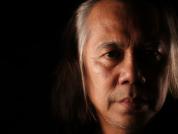
Sardono Kusumo
Sardono Kusumo, described by the New York Times as Indonesia’s “most famous but also most rebellious choreographer and dancer”, was born in Solo on the island of Java in 1945. He trained in the alusan (refined) style of court dance yet cites his initiation into dance as having occurred via pencak silat, an Indonesian martial art.
As a child, Sardono embarked upon a course of study that blended martial arts with traditional Javanese dance, focusing on developing characters from the Mahabarata and Ramayana epics under the guidance of renowned Indonesian dancer Kusumo Kesowo.
At the age of 20, Sardono traveled to New York to immerse himself in American modern dance, which he stayed to study and observe for several years. The points he would draw, and the different styles he examined through this time, would help to shape his career to come. Upon return to Indonesia, Sardono began to make his name as a leading figure in Indonesian dance, staging workshops at Jakarta’s esteemed Taman Ismail Marzuki (TIM) Art Centre.
His first work, Samgita, drew strong responses from its Solo audience. Staged in 1969, audience members were reportedly so outraged by the controversial performance they threw rotten eggs and other spoiled food onto the stage. “They got angry because I had asked the female dancers to raise their legs as high as in the Prambanan reliefs,” Sardono later explained, referring to the sacred reliefs that inspired the piece. Challenging both his dancers and his audience soon became Sardono’s calling card.
In 1972, Sardono traveled to Bali and began to work with an integrated group of Javanese and Balinese dancers on local forms. He would again draw attention for his work, outraging local society and the Balinese authorities alike. Sardono would make it a point to work with dancers from across Indonesia’s more than 17,000 islands in the years to come. He founded the Sardono Dance Theatre in 1973.
Sardono has drawn a range of social, political and environmental messages into his pieces, including Plastic Jungle (1983), Lamenting Forest(1988) and Nobody’s Body (2002). Sardono describes himself as a “cross-cultural traveler” and, speaking to the publication Tiras, commented, “I dance as a man who has lost or been uprooted from his own culture.”
The work Opera Diponegoro, which premiered in the early 1990s and has been described by Indonesia’s leading newspaper Kompas as “perhaps one of Sardono’s best works ever”, tells the story of the heroic struggle of Indonesia’s patriot, Prince Diponegoro who rose up against Dutch colonial rule. Sardono integrates the classic Raden Saleh painting of Diponegoro’s arrest by Dutch authorities into the piece, inviting audiences to contemplate both still and dynamic representations of the individual and national struggle.
 The participation of the Sardono Dance Theater is made possible through the generous support of Citi Foundation, the National Endowment for the Arts, the Asian Cultural Council, the New York State Council for the Arts and Medco Energi. Special thanks to the Consulate General of the Republic of Indonesia.
The participation of the Sardono Dance Theater is made possible through the generous support of Citi Foundation, the National Endowment for the Arts, the Asian Cultural Council, the New York State Council for the Arts and Medco Energi. Special thanks to the Consulate General of the Republic of Indonesia.Prince Diponegoro is considered a national hero in Indonesia's struggle for independence and autonomy.
Read on for more on this historic figure, the modern day choreographer who has been inspired by him and the resonance of Indonesia's search for self-rule in the nation's artistic and cultural scene today.



